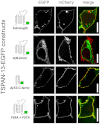Tetraspanin-13 modulates voltage-gated CaV2.2 Ca2+ channels
- PMID: 23648579
- PMCID: PMC3646272
- DOI: 10.1038/srep01777
Tetraspanin-13 modulates voltage-gated CaV2.2 Ca2+ channels
Abstract
Integration of voltage-gated Ca(2+) channels in a network of protein-interactions is a crucial requirement for proper regulation of channel activity. In this study, we took advantage of the specific properties of the yeast split-ubiquitin system to search for and characterize so far unknown interaction partners of CaV2 Ca(2+) channels. We identified tetraspanin-13 (TSPAN-13) as an interaction partner of the α1 subunit of N-type CaV2.2, but not of P/Q-type CaV2.1 or L- and T-type Ca(2+) channels. Interaction could be located between domain IV of CaV2.2 and transmembrane segments S1 and S2 of TSPAN-13. Electrophysiological analysis revealed that TSPAN-13 specifically modulates the efficiency of coupling between voltage sensor activation and pore opening of the channel and accelerates the voltage-dependent activation and inactivation of the Ba(2+) current through CaV2.2. These data indicate that TSPAN-13 might regulate CaV2.2 Ca(2+) channel activity in defined synaptic membrane compartments and thereby influences transmitter release.
Figures


 - cells transfected with an EGFP control plasmid (n = 26);
- cells transfected with an EGFP control plasmid (n = 26);  - cells transfected with a plasmid encoding TSPAN-13-EGFP (n = 26). (c) I-V relationship for the recombinant CaV3.1 channel stably expressed in a HEK 293 cell line.
- cells transfected with a plasmid encoding TSPAN-13-EGFP (n = 26). (c) I-V relationship for the recombinant CaV3.1 channel stably expressed in a HEK 293 cell line.  - cells co-transfected with an EGFP control plasmid (n = 22);
- cells co-transfected with an EGFP control plasmid (n = 22);  - cells co-transfected with a plasmid encoding TSPAN-13-EGFP (n = 19). (d) I-V relationship for the recombinant CaV1.2 channel stably expressed in a HEK 293 cell.
- cells co-transfected with a plasmid encoding TSPAN-13-EGFP (n = 19). (d) I-V relationship for the recombinant CaV1.2 channel stably expressed in a HEK 293 cell.  - cells co-transfected with an EGFP control plasmid (n = 18);
- cells co-transfected with an EGFP control plasmid (n = 18);  - cells co-transfected with a plasmid encoding TSPAN-13-EGFP (n = 20). (e) I-V relationship for the recombinant CaV2.2 channel stably expressed in a CHO cell line.
- cells co-transfected with a plasmid encoding TSPAN-13-EGFP (n = 20). (e) I-V relationship for the recombinant CaV2.2 channel stably expressed in a CHO cell line.  - cells co-transfected with an EGFP control plasmid (n = 16);
- cells co-transfected with an EGFP control plasmid (n = 16);  - cells co-transfected with a plasmid encoding TSPAN-13-EGFP (n = 15).
- cells co-transfected with a plasmid encoding TSPAN-13-EGFP (n = 15).

 ) and cells transfected with TSPAN-13 (
) and cells transfected with TSPAN-13 ( ). Straight lines represent linear fits of experimental data. (c) Gmax/Qmax ratio for TSPAN-13 and various TSPAN-13 constructs. Number of cells tested is indicated at each column. ** - significantly different from control, p < 0.01. Abbreviations: FL-TSPAN-13, full-length-TSPAN-13; δ, regions that are deleted in TSPAN-13 constructs.
). Straight lines represent linear fits of experimental data. (c) Gmax/Qmax ratio for TSPAN-13 and various TSPAN-13 constructs. Number of cells tested is indicated at each column. ** - significantly different from control, p < 0.01. Abbreviations: FL-TSPAN-13, full-length-TSPAN-13; δ, regions that are deleted in TSPAN-13 constructs.
References
Publication types
MeSH terms
Substances
LinkOut - more resources
Full Text Sources
Other Literature Sources
Molecular Biology Databases
Miscellaneous

